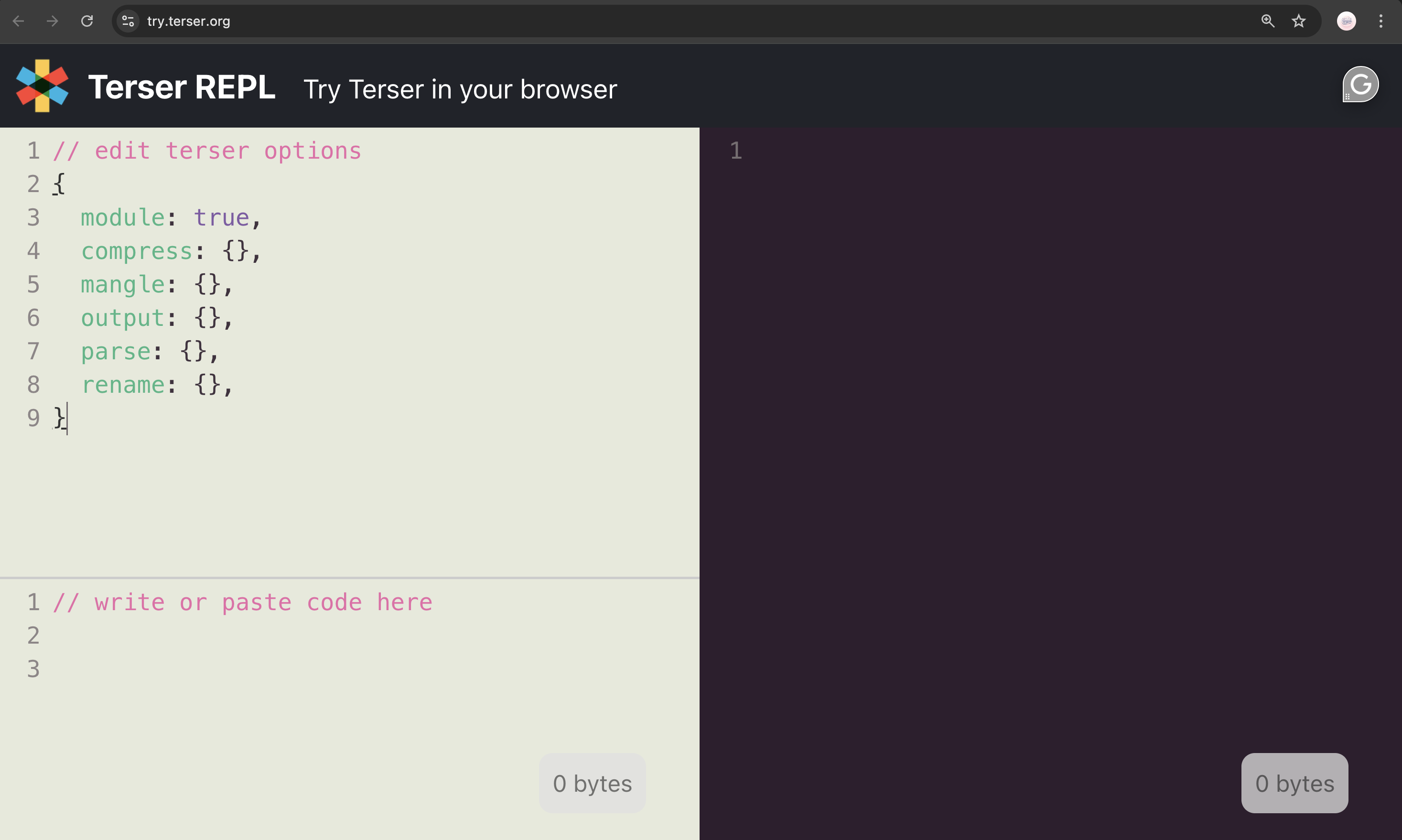Minification in JavaScript: Making Sites Lighter

Performance has got to be the main principle of web development. End users expect quick-load websites with a seamless experience. One such way to tackle this is minification, a very important procedure when considering JavaScript optimization in delivering code to users. But what exactly is minification, and why is it so important? This article clarifies the concept for JavaScript, its benefits, how it is done, and how it is applied in some of the popular JavaScript frameworks.

Discover how at OpenReplay.com.
Minification is the process of removing all unnecessary characters from the source code without changing its functionality. These characters include white spaces, line breaks, comments, and occasionally even renaming variables into shorter names. In this case, the primary goal is to reduce the size of the JavaScript file, which eventually leads to a faster loading time for web apps.
Consider a simple JavaScript function before and after minification:
function greetUser(name) {
console.log("Hello, " + name + "!");
}
greetUser("Jake");The minified code below is more compact:
function greetUser(name){console.log("Hello, "+name+"!")}greetUser("Jake");Spaces and line breaks are removed, reducing the overall file size, making it quicker to transfer over the network.
Why is Minification Important?
Below are major reasons why it’s important to minify our code base:
-
Improved Load Times: Because minified JavaScript files are reduced in size, they will load faster on the user’s browser. This reduction in load time is crucial for users with slower internet connections and those browsing websites from their mobile devices.
-
Bandwidth Savings: Minification decreases the volume of data transferred between the server and the client. It would save a lot of bandwidth costs, especially with high-traffic sites.
-
Performance Enhancement: Improved loading times mean improved overall performance. Users are very likely to stay on a site that loads fast, which decreases the bounce rate and improves the user experience.
-
Obfuscation: Although not the primary goal, in nature, it can be less readable, offering a minimal form of obfuscation in this way. This will discourage casual observation of the code but should not at all be relied upon for security.
Minification Tools and Libraries
While minification is a process that can be done by hand, this is not practical for most applications with large codebases. Developers use automated tools to minify code quickly and efficiently. Here’s a closer look at some of the most popular tools and libraries:
1. UglifyJS

UglifyJS is one of the very first minification tools for JavaScript. It is a complete toolkit for JavaScript parsing, minification, compression, and beautification of the source code. UglifyJS supports ES5 syntax, which allows using it with both older projects and those that do not require new modern features of JavaScript.
Some of its key features are:
- Compression: The UglifyJS library can shrink your JS files by removing whitespace, comments, and unnecessary semicolons. It also shortens the variable and function names to minimize the code further.
- Mangling: It replaces variables and function names with shorter ones; this size reduction is usually very great. Dead Code Elimination: UglifyJS is capable of detecting and removing unreachable code, a process known as dead code elimination or tree shaking.
- Source Maps: UglifyJS can generate source maps that allow developers to debug minified code by mapping it back to the source code.
2. Google Closure Compiler

Google Closure Compiler is a sophisticated JavaScript optimization tool. Unlike trivial minifiers, it rewrites your code to achieve the maximum possible size reduction. It’s suitable for big projects and apps with the most stringent performance requirements.
Some key features it has, include:
- Advanced Optimizations: The Closure Compiler not only minifies the code but also analyzes and rewrites it to be faster and smaller through advanced dead code elimination, function inlining, and loop optimization. Type Checking: Closure Compiler can perform type checking, which enables it to catch probable errors in code before they can become runtime issues.
- Cross-Browser Support: This tool ensures that optimized code is cross-browser, offering an alternative for the developer to rely on while using it in web applications.
- Modular Compilation: With this feature, code can be broken into modules and separately compiled on these modules; therefore, integration at a later stage results in a reduced final bundle size.
3. Terser

Terser is a modern JavaScript minifier based on UglifyJS that targets ES6+ syntax support. It is highly useful in modern web development projects that require handling JavaScript’s new features, such as arrow functions, classes, and template literals.
Key Features of Terser are:
ES6+ Support: It is built to support JavaScript’s new specifications, working perfectly with modern code. It is good for any project based on ES6 and newer versions.
- Source Maps: Similar to UglifyJS, it supports source maps for debugging minified code.
- Good Plugin Integration: The tool is well integrated with Webpack, Rollup, Gulp, and many other build tools, so including it in the workflow is quite easy.
- Code Mangle and Compression: Terser comes with advanced options to mangle and compress code to the best minimal output.
Integrating Minification into Your Workflow
It is best to integrate minification into your development workflow. For example, Webpack, Gulp, and Grunt could be configured to do JavaScript file minification automatically when building. In this way, your production code will always be minified without any manual interference.
If you’re using Webpack, you can integrate minification by configuring the TerserPlugin in your Webpack config file:
const path = require("path");
const TerserPlugin = require("terser-webpack-plugin");
module.exports = {
mode: "production", // Important for minification
entry: "./src/index.js",
output: {
filename: "bundle.js",
path: path.resolve(__dirname, "dist"),
},
optimization: {
minimizer: [new TerserPlugin()],
},
};This setup ensures that your JavaScript files are automatically compiled every time you build your project. Minification is enabled with mode: production' inside your Webpack configuration, and the process is actually carried out by TerserPlugin. The bundle output, bundle.js, is created in the dist directory.
Minification in JavaScript Frameworks
JavaScript frameworks are used extensively for modern web development, and most of them come with tools and configurations built for minification. Let’s examine, in detail, the working process of minification in two of the popular frameworks: React and Angular.
How Minification Works in React
React happens to be a JavaScript library used most commonly in building user interfaces, especially single-page applications. Minification is also inherent in the process when working with React, and CRA(Create React App) in particular, through building for production.
Often, when using Create React App to scaffold a new React application, one would execute npm run build as a way of creating a production-ready version of the application. That command would trigger Webpack to go ahead with the minification of your JavaScript files. This is achieved by Terser, a strong JavaScript compressor that removes the characters that are not needed and optimizes the code for performance.
Consider a React component that displays a simple message:
import React from "react";
function WelcomeMessage({ name }) {
return <h1>Hello, {name}!</h1>;
}
export default WelcomeMessage;When you build this application using the npm run build command, Webpack will create a minified version of this component. Here’s what the minified code might look like:
function WelcomeMessage(e){return React.createElement("h1",null,"Hello, ",e.name,"!")}export default WelcomeMessage;See how much more compact the minified code is? It cuts out all the spaces, line breaks, and comments. The variable names are probably optimized to something a bit more concise too. However, minified files in React aren’t just smaller in size; they run faster in the app and make your application feel snappier to your users.
Advanced Optimizations
Webpack also does other types of optimizations in React, like tree-shaking. Tree-shaking is the process of eliminating dead code, which would never be used within an application. This, in combination with minification, gives us a final bundle that is small and lean.
How Minification Works in Angular
Angular is a holistic framework for creating dynamic web apps. It contains a strong CLI(Command Line Interface), which is provided with a lot of tools integrated to help optimize your application. Minification happens to be one of them.
The build and minification in Angular are linked, together using the CLI. After the ng build --prod command, when building an Angular application for production, the CLI will apply minification by default over the JavaScript files. The process includes steps like Ahead-of-Time (AOT) compilation, tree-shaking, and minification.
Let’s consider an Angular component that displays a greeting message:
import { Component, Input } from "@angular/core";
@Component({
selector: "app-greeting",
template: `<h1>Hello, {{ name }}!</h1>`,
})
export class GreetingComponent {
@Input() name: string;
}After running ng build --prod, the Angular CLI generates a minified version of this component:
"use strict";self.webpackChunkangular=self.webpackChunkangular||[]).push([[179],{1301:(t,n,r)=>{"use strict";r.r(n),r.d(n,{GreetingComponent:()=>c});var e=r(6733);let c=(()=>{class t{constructor(){this.name=""}}return t})(),e.ɵɵdefineComponent({type:c,selectors:[["app-greeting"]],inputs:{name:"name"},decls:2,vars:1,consts:[[1,"greeting"]],template:function(t,n){1&t&&(e.ɵɵelementStart(0,"h1"),e.ɵɵtext(1),e.ɵɵelementEnd())},encapsulation:2})}}]);This is a minified version for shortening variable names, removing white space, and putting code into fewer lines. This reduces not only the file size but also optimizes the performance of the Angular application.
Through the Ahead-of-Time (AOT) Compilation, Angular compiles templates into executable JavaScript code during the build process. It reduces browser-executable code and shortens application start-up time to a great extent. This approach uses tree-shaking to get rid of all the unused code and lower the final bundle size. Angular will also minify the CSS and HTML files to be loaded more quickly.
Conclusion
Minification is an integral process during the production build of Javascript and its frameworks. It helps in reducing file size, thus enabling a better loading time and performance, and hence an overall good experience for the user.



